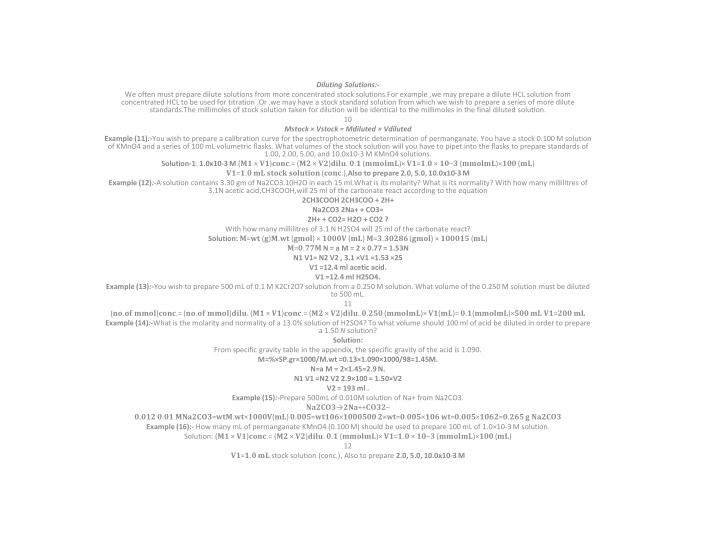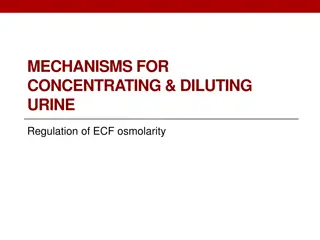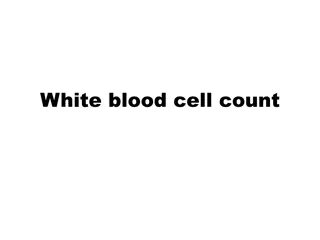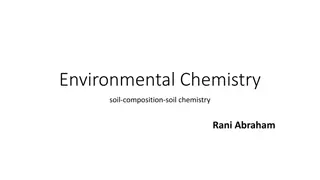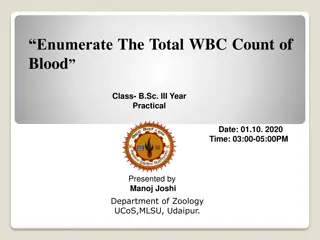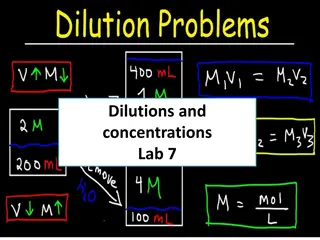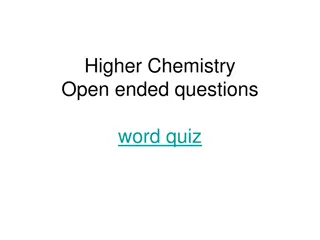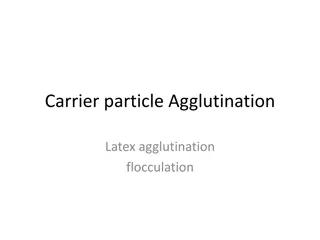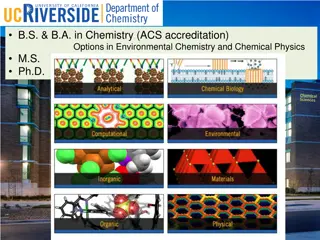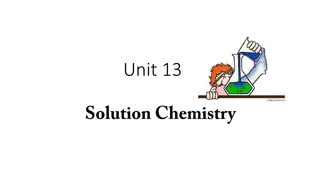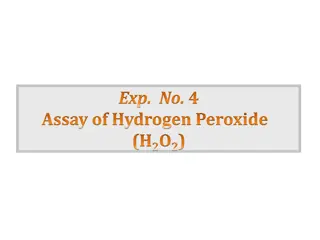Diluting Solutions in Chemistry
Diluting solutions is a common practice in chemistry to prepare solutions of different concentrations for various experiments and analyses. This involves diluting stock solutions to desired concentrations using the formula M1V1 = M2V2. The process includes preparing calibration curves, determining molarity and normality, calculating formula weights, and solving various solution preparation problems.
Download Presentation

Please find below an Image/Link to download the presentation.
The content on the website is provided AS IS for your information and personal use only. It may not be sold, licensed, or shared on other websites without obtaining consent from the author.If you encounter any issues during the download, it is possible that the publisher has removed the file from their server.
You are allowed to download the files provided on this website for personal or commercial use, subject to the condition that they are used lawfully. All files are the property of their respective owners.
The content on the website is provided AS IS for your information and personal use only. It may not be sold, licensed, or shared on other websites without obtaining consent from the author.
E N D
Presentation Transcript
Diluting Solutions:- We often must prepare dilute solutions from more concentrated stock solutions.For example ,we may prepare a dilute HCL solution from concentrated HCL to be used for titration .Or ,we may have a stock standard solution from which we wish to prepare a series of more dilute standards.The millimoles of stock solution taken for dilution will be identical to the millimoles in the final diluted solution. 10 Mstock Vstock= Mdiluted Vdiluted Example (11):-You wish to prepare a calibration curve for the spectrophotometric determination of permanganate. You have a stock 0.100 M solution of KMnO4 and a series of 100 mL volumetric flasks. What volumes of the stock solution will you have to pipet into the flasks to prepare standards of 1.00, 2.00, 5.00, and 10.0x10-3 M KMnO4 solutions. Solution-1: 1.0x10-3 M (?? ??)????.= (?? ??)????. ?.?(??????) ??=?.? ?? ?(??????) ???(??) ??=?.??? ?????????????(????.),Also to prepare 2.0, 5.0, 10.0x10-3 M Example (12):-A solution contains 3.30 gmof Na2CO3.10H2O in each 15 ml.What is its molarity? What is its normality? With how many millilitres of 3.1N acetic acid,CH3COOH,will 25 ml of the carbonate react according to the equation 2CH3COOH 2CH3COO + 2H+ Na2CO3 2Na+ + CO3= 2H+ + CO2= H2O + CO2 ? With how many millilitres of 3.1 N H2SO4 will 25 ml of the carbonate react? Solution: ?=?? (?)?.?? (????) ?????(??) ?=?.?????(????) ??????(??) ?=?.???N = a M = 2 0.77 = 1.53N N1 V1= N2 V2 , 3.1 V1 =1.53 25 V1 =12.4 ml acetic acid. V1 =12.4 ml H2SO4. Example (13):-You wish to prepare 500 mL of 0.1 M K2Cr2O7 solution from a 0.250 M solution. What volume of the 0.250 M solution must be diluted to 500 mL. 11 (??.?? ????)????.= (??.?? ????)????. (?? ??)????.= (?? ??)????. ?.???(??????) ??(??)= ?.?(??????) ???????=????? Example (14):-What is the molarity and normality of a 13.0% solution of H2SO4? To what volume should 100 ml of acid be diluted in order to prepare a 1.50 N solution? Solution: From specific gravity table in the appendix, the specific gravity of the acid is 1.090. M=% SP.gr 1000/M.wt=0.13 1.090 1000/98=1.45M. N=a M = 2 1.45=2.9 N. N1 V1 =N2 V2 2.9 100 = 1.50 V2 V2 = 193 ml . Example (15):-Prepare 500mL of 0.010M solution of Na+ from Na2CO3. ?????? ???++???? ?.????.?????????=???.?? ?????(??) ?.???=????? ???????? ??=?.??? ?????=?.??? ????=?.???? ?????? Example (16):- How many mL of permanganate KMnO4 (0.100 M) should be used to prepare 100 mL of 1.0 10-3 M solution. Solution: (?? ??)????.= (?? ??)????. ?.? (??????) ??=?.? ?? ? (??????) ???(??) 12 ??=?.??? stock solution (conc.), Also to prepare 2.0, 5.0, 10.0x10-3 M
Example (17):- What volume of the 0.250 M of K2Cr2O7 solution must be diluted to prepare 500 mL of 0.1 M solution. (?? ??)????.= (?? ??)????. ?.??? (??????) ??(??)= ?.?(??????) ??? ?? ??=??? ?? Example (18):- What volume of 0.40 M Ba(OH)2 must be added to 50 mL of 0.30 M NaOH to give a solution 0.50 M in OH. Let x = mL Ba(OH)2 and the final volume is (50+x) mL ????? ?? =????? ????+? ???? ??(??)? ?.? ? (??+?)??=?.?? ? ?? ??+? (?.?? ? (?) ??) ?=?? ?? ??(??)? Example (19):- Prepare 500mL of 0.010M solution of Na+ from solid Na2CO3. ?????? ???++???? ?.??? ?.?? ???????=???.?? ?????(??) , ?.???=????? ??????? ? ??=?.??? ??? , ??=?.?? ????=?.??? ? ??????
Problems Q1:Calculate the formula weights of the following substance :(a) BaCl2.2H2O, (b)Ag2Cr2O7 ,(c)Ca(PO4)2. Q2:Asolution containing 10 mmol CaCl2 is diluted to 1 L. Calculate the number of grams of CaCl2.2H2O per milliliter of the final solution? Q3:Calculate the molarity of each of the following solutions: (a) 10 gm H2SO4 in 250 ml of solution,(b)6 gm NaOH in 500 ml of solution,(c)25 gm AgNO3 in 1L of solution. Q4:Calculate the number of grams in 500 ml of each of the following solutions:(a) 0.1 M Na2SO4 ,(b) 0.250 M Fe(NH4)2(SO4)2.6H2O ,(c) 0.667 M Ca(C9H6ON)2 . 13 Q5:Calculate the grams of each substance requied to prepare the following solutions:(a)250 ml of 0.1 M KOH , (b) 1L of 0.0275 M K2Cr2O7 ,(c)500 ml of 0.05 M CuSO4 . Q6:How many milliliters of concentration hydrochloric acid , 38 %(wt/wt) , specific gravity 1.19, are required to prepare 1L of a 0.1 M solution? Q7:Calculate the molarity of each of the following commercial acid or base solutions:(a) 70% HClO4 , sp. grv. 1.668 , (b)69% HNO3 , sp. grv. 1.409 , (c) 85% H3PO4 , sp. grv. 1.689 ,( d)99.5% HC2H3O2(acetic acid) , sp. grv. 1.051 , (e)28% NH3 , sp. grv. 0.898 . Dilution calculation Q8/A 12.5-mL portion of a solution is diluted to 500 mL, and its molarity is determined to be 0.125. What is the molarity of the original solution? Q9/ What volume of 0.50 M H2SO4 must be added to 65mL of 0.20 M H2SO4 to give a final solution of 0.35 M? Assume volumes are additive. Q10/You are required to prepare working standard solutions of 1.00 10 5, 2.00 10 5, 5.00 10 5, and 1.00 10 4 M glucose from a 0.100 M stock solution. You have available 100-Ml volumetric flasks and pipets of 1.00-, 2.00-, 5.00-, and 10.00-mL volume. Outline a procedure for preparing the working standards. Formal concentration (Formality) F:- Chemists sometime use the term formality for solutions of ionic salts that do not exist as molecules in the solid or in solution. The concentration is given as formal(F).Formality is numerically the same as molarity. ?=?? (?)?.?? (????) ????? (??) The term use for solutions of ionic salts that do not exist as molecules in the solid or in solution. Operationally, formality is identical to molarity. Example (20): Exactly 4.57 g of BaCl2.2H2O are dissolved in sufficient water to give 250mL of solution. Calculate the formal concentration of BaCl2 and Cl- in this solution. Solution 14 ??????=????? ????? ??=?.????? ???????=?.???? ? ?????.???? ????? ???++??? ?.????? ?.????? ?=?.???? ??
Normality (N): Normal concentration: Number of equivalent solute in solution volume in litre. ?=??.?? ?????????????????? ?????? (?)=?????????? ?????? (????)? (??)???? (???) ?=????.?? ????? (??) ?=(???)=(?????) Equivalent weight (Eq.wt):- is the formula weight divided by the number of reacting units (H+ for acid-base and electron for oxidation-reduction reaction). (??.??) ??? ???? ???? ????????=??????? ?????? (?.??)??.?? ?+ ?? ?? (??.??) ??? ????????? ????????? ????????=??????? ?????? (?.??)??.?? ???????? ?????? ?? ?????????? (??)=?? (??)??.?? (????) ?????? ?? ?????????? (??)=? (???) ?????? (?) ?????? ?? ??????????????? (???)=?? (??)??.?? (?????) ?????? ?? ??????????????? (???)=? (?????) ?????? (??) Example (21):- Calculate the equivalent weight of the following substances: (a) NH3, (b) H2C2O4 (in reaction with NaOH), and (c) KMnO4 [Mn7+ is reduced to Mn2+]. (a) ?? ??=?????.?? ?+ ?? ?? = ??.???=??.?? ??/?? 15 (b) ?? ??=??.???=??.?? ??/?? (c) ???? + ??++ ??= ??+?+ ???? ?? ??=?.????.?? ????????=???.???=??.??? ??/?? Example (22) :-Calculate the normality of the solutions containing the following: (a) 5.300gm/L Na2CO3 (when the CO3-2 reacts with two protons), (b) 5.267 gm/L K2Cr2O7 (the Cr6+ is reduced to Cr3+). Solution:(a) ?=????.?? ????? (??)=?.????.??? ????????=?.?? ??/? (b) ?????? +???++?? ????++ ???? =?.??????.??? ????????=?.???? ??/? Example (23) :-How many millilitres of a 0.25M solution of H2SO4 will react with 10mL of a 0.25M solution of NaOH. Solution: ?=?? (?=??.?? ?????????? , ?+,?? ,?? ????????) ??????=? ?.?? =?.? (???)?? (?????)?? ? ?????=? ?.??=?.?? ? (? ?)?????= (? ?)???? (?.? ? )?????=(?.?? ??)???? ??????=?.? ?? Example (24):-A solution of sodium carbonate is prepared by dissolving 0.212 gm Na2CO3 and diluting to 100mL. Calculate the normality of the solution (a) if it is used as a monoacidic base, and (b) if it is used as a diacidic base. Solution:(a) ?=????.?? ????? (??)=?.??????.?? ???????=?.??? ???/?? 16 (b) ?=?.??????.?? ???????=?.??? ???/?? Example (25):-Iodine (I2) is an oxidizing agent that in reactions with reducing agent is reduced to iodide (I-). How many grams I2 would you weigh out to prepare 100mL of a 0.10N I2 solution? Solution: ??+?? ?? ?=????.?? ????? (??) ?.?=?????? ??????? ??=?.??? Example (26):-Calculate the normality of a solution of 0.25 g/L H2C2O4, both as an acid and as a reducing agent. Solution: ?????? ????+ ??? ?=????.?? ????? (??)=?.?????.??? ???????? =?.????? ???/?? Example(27):-How many milliequivalents are involved in 43.50mL of 0.1379 N K2Cr2O7? Solution: ??.?? ????????????????=? ? =?.????????? ??.?? ?? =?.???? ???
Problems Q1:To what volume must 750 ml of 2.4 N solution be diluted in order to make it 1.7N? Q2:How much 0.6 N base must be added to 750 ml of a 0.2 N base in order the solution to be 0.3 N ? Q3: How many volume of 0.1421 N KOH solution are required to neutralize 13.72 ml of 0.0686 M H2SO4 ? 17 Concentration by percent:- (????%)=?? ??????(?)?? ????????????????(?) ??? =?? ??????(??)?? ?????????? ??????(??) ??? (???%)=?? ??????(?)? ????????????????(??) ???=?? ?????? (??)? ????????????????(??) ???(??%)=? ??????(??)?????????????????(??) ???=? ??????( ?)?????????????????(??) ??? Example(28):-Calculate the weight percentage of solution prepare by mixing 5.0g AgNO3 with 100mL water (density 1g/cm3). Solution: (????%)=?? ?????? (?)?? ????????(?) ???(????%)=?? ??????(?????)(?)????????+????????? (???) (?) ???(????%)=? ?? ?+(??? ?? ????) ???=????? ? ???=?.??% Example(29):-Calculate number of grams in 500mL silane solution (wt/v % = 0.859%). Solution: (???%)=?? ??????(?)? ????????(??) ????.???%=?? ???? (?)??? ???, ?? ????=?.??? ??????=?.??? ???? Example (30):-Calculate the weight of glucose in litter solution(wt/v % = 5 %). Solution: 18 (???%)=?? ?????? (?)? ????????(??) ???=????????? (?)? ????????(??) ??? ?%=?? ???????(?)????(??) ???, ?? ???????=? ???????=??? Example(31):-Calculate the volume percentage of solution preparing by mixing 50mL methyl alcohol with 200mL water. Solution: (??%)=? ??????(??)??????????? ??????(??) ???=? ?????????????(??)??????????????+??????(??) ???=????(??+???)?? ???=??% (5) Molality m (Molal concentration):-The solution concentration produce from dissolved solute (mole) in solvent (kg), molality does not change with temperature and used for physicochemical measurements. Example(32): -Calculate the molal concentration for solution preparing from mixing 4 g NaOH with 500 g water. ????????(?)=???.?? ??????(?)=? ??? ?/??? ???????=?.?? Mole fraction concentration (X):- The ratio between number of mole for solute or solvent to solution, the terms used in physical chemistry (phases equilibrium for example). Example(33):-One litter of acetic acid solution contain 80.8 g of acetic acid, the solution density 1.00978 g/cm3 or g/mL.(cm3 = mL) Solution: ???? ???????? ??? ??????(??)=??.???? ??????(??)??.???? ??????(??)+??.???? ??????? (??) =(??(?)?.??(????))???????(??(?)?.??(????))???????+(????????? ????????(???) ???????? ????????(??) ???? ??????(?))(????? ??????? (????) ) 19 =??.?(?)??(????)??.?(?)??(????)+(?.??????(???) ?????? ??.?? ??(????))=?.??????? ???????? ?????????? (??)=??.???? ?????????.??????????(??)+??.???? ??????? (??) =(?.??????(???) ?????? ??.?? ??(????))??.?(?)??(????)+(?.??????(???) ?????? ??.?? ?? (????))=?.?????+??=? ????=?.???+?.???=?.??????
Analytical Molarity: The analytical molarity of a solution gives the total number of moles of a solute in 1 L of the solution (or the total number of millimoles in I mL). That is, the analytical molarity specifies a recipe by which the solution can be prepared. For example, a sulfuric acid solution that has an analytical concentration of 1.0 M can be prepared by dissolving 1.0 mol, or 98 g, of H2SO4 in water and diluting to exactly 1.0 L. Equilibrium Molarity: The equilibrium molarity expresses the molar concentration of a particular species in a solution at equilibrium. To state the species molarity, it is necessary to know how the solute behaves when it is dissolved in a solvent. For example, the species molarity of H2SO4 in a solution with an analytical concentration of 1.0 M is 0.0 M because the sulfuric acid is entirely dissociated into a mixture of H+, HSO4-, and SO42- ions; essentially no H2SO4 molecules as such are present in this solution. The equilibrium concentrations and thus the species molarity of these three ions are 1.01, 0.99, and 0.01 M, respectively. Example (34):- Calculate the formal concentration of: (a) an aqueous solution that contains 1.80g of ethanol in 750mL. (b) An aqueous solution that contains 365mg of iodic acid HIO3 in 20.0mL (the acid is 71.0% ionized in this solution). 20 Solution: (a) ??????=????? ???????=?.????.? ???????=?.????? ?????? The only solute species present in significant amount in an aqueous solution of ethanol is C2H5OH, therefore; ?=?=?.???? (b) ?=????? ???????=?????????? ??????=?.???? Here, only 29.0% (100%-71.0%) of the solute exists as undissociated HIO3. Thus, the molar concentration of this species will be: ??.???? ?.????=?.????????? Example (35):- Calculate the analytical and equilibrium molar concentration of the solute species in an aqueous solution that contains 285 mg of trichloroacetic acid, Cl3CCOOH (Fwt=163.4) in 10.0mL (the acid is 73% ionized in water). Employing HA as the symbol for Cl3CCOOH, we substitute into equation (law) to obtain the analytical or total concentration of the acid. Solution ???=???.?? ???????=??????????.? ??????=?.?????????/??=?.???? ?? Because all but 27% of the acid is dissociated into H3O+ and A-, the species concentration of HA is: [??]=??? ??.????=?.???????/??=?.???? The molarity of H3O+ as well as that of A- equal to the analytical concentration of the acid minus the species concentration of undissociated acid [???+]=[? ]=?.??? ?.???=?.??? ????/??=?.???? Note: the analytical concentration of HA is the sum of the species concentration of HA and A- ???=[??]+[? ]=[??]+[???+] The relationship between molarity or normality with percentage concentration:- 21 Example (36):-Calculate the molar concentration for 0.85% (w/v%) sodium chloride solution. ?=?? (?)?.?? ???????=?? (?)?.?? ???????=???% ?????.?? =?.????? ??????.?=?.????
